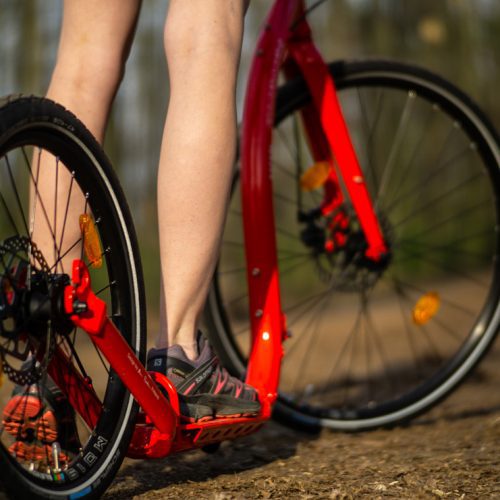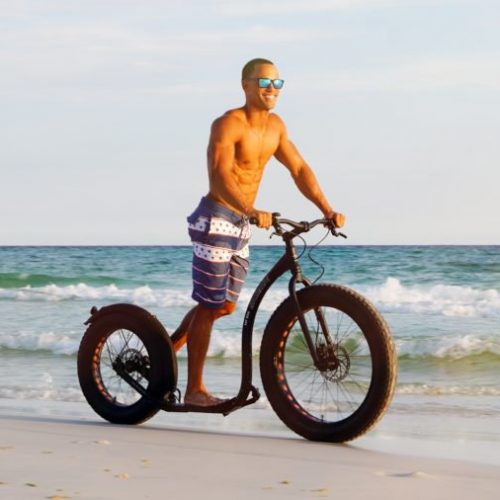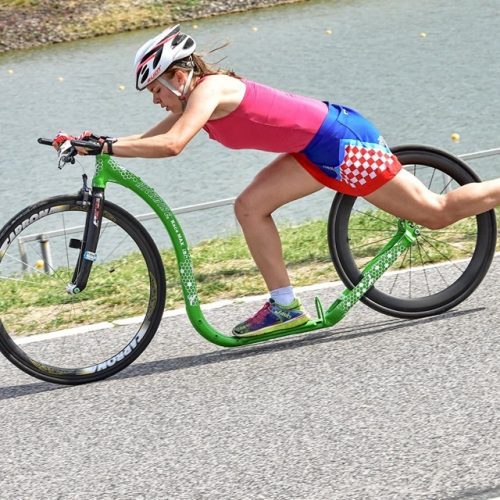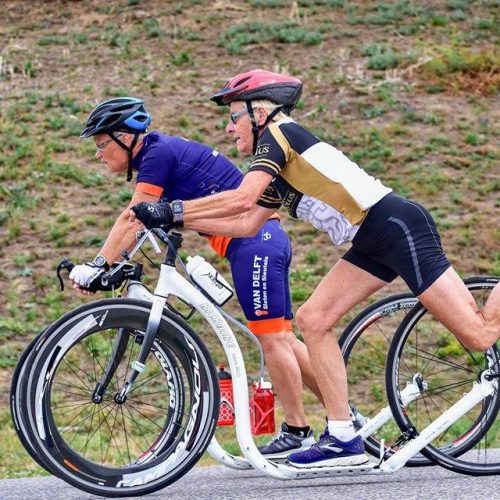Kickbike: A Physical Therapist’s Observational Perspective
By Andrea Avruskin PT, DPT, ATC, LAT, CKTP | Physical Therapist, Athletic Trainer, Health Writer
Overview
Kickbike is an excellent tool for rehabilitation, training and conditioning. It challenges lower body strength, power, endurance and balance, as well as trunk and upper body stability and endurance. It is suitable for non-athletic people and athletes who are healthy, recovering from injuries, or preventing injuries.

Joints
Impact Stress
Kickbike provides an intense cardiopulmonary workout without high-impact stress on joints from repetitive pounding on the pavement (as in running). This is an advantage for anyone with thinning joint cartilage, or anyone with an interest in preventing cartilage damage, as one can enjoy speed and athletic activity with a reduced exposure of joints to the high-impact compressive forces of running.
Range of Motion
The joint range of motion (ROM) required to use the Kickbike recreationally is less at the knee and hip than is required to ride a regular bicycle or even to climb stairs. Therefore, the Kickbike can be a useful and enjoyable tool for people who don’t have full ROM or are working on improving their range of motion.
Competitive racing on the Kickbike requires more ROM in a few joints than recreational riding requires. 100-110 degrees of hip flexion ROM is needed due to a flexed trunk-on-leg position typically favored by competitive racers. Shoulder flexion ROM of approximately 110-130 degrees of glenohumeral joint flexion is also required to attain this racing position.
Posture
A racing bicycle forces a seated rider to maintain sustained lumbar and hip flexion and cervical extension positioning, which often lead to back and neck discomfort or fatigue. Body alignment on the Kickbike, however, allows a user to maintain more normal lumbar lordosis, thoracic kyphosis and cervical lordosis.
The upright, more natural posture on the Kickbike may also help users avoid shortening and tightening of the psoas muscles, which can occur during sustained flexion positioning of the hip, such as that required in using a racing bicycle.

Propelling Leg
Riding a regular bicycle targets proximal muscles in the leg, such as the gluteals and hamstrings. When using a Kickbike, foot contact with the ground during propulsion requires peripheral muscles, such as the foot and toe muscles, to generate force as well. A greater number of distal muscles are challenged during a Kickbike workout than during a regular bicycle workout.
The posterior hip and leg muscles in the propelling leg use an explosive concentric contraction to propel the Kickbike. Recruited muscles include the gluteal muscles, hamstrings, gastrocnemius and soleus, peroneals, posterior tibialis, flexor digitorum and flexor hallicus longus, as well as the foot intrinsics.
Standing Leg
On a regular bicycle, the majority of weight bearing when the rider is in the seated position is on the bicycle seat, at the groin level. The distance from the seat to the “core” of a rider’s body (i.e. the lower abdominal and pelvic floor muscles) forms a lever arm length of only a few inches that the core muscles must control to maintain upright balance.
On a Kickbike, weight bearing is at the end of the leg, at the foot. Therefore, the lever arm is the entire length of the standing leg – several feet in length. This longer lever arm forces the core and leg muscles to work harder to stabilize the body standing on the Kickbike than they would need to if the body was seated.
When a bicycle rider is in a standing position, the lower body lever arm is also equal to the length of the leg. However, a bicycle rider stands on two feet that are positioned laterally to his/her center of gravity. This creates two points of contact and a wider base of support than the Kickbike single point of contact. A wider base of support makes balancing easier, allowing core and leg muscles to work less hard to maintain balance. A single point of contact is a narrow base of support, as on the Kickbike, and requires more muscular work to maintain upright balance.
The Kickbike challenges the isometric and eccentric strength of the hip, knee, and ankle muscles in the standing leg, and the pelvic, abdominal and spine muscles in the trunk. These muscles include: the peroneals, posterior tibialis, flexor digitorum, flexor hallucis longus, anterior tibialis, gluteal muscles, hamstrings, quadriceps, tensor fascia lata, adductor magnus, gracilis, sartorius, pyramidalis, psoas, iliacus, quadratus lumborum, rectus abdominis, transverse abdominis, and erector spinae.

Upper Body
To steer and brake the Kickbike, the hands are placed on bicycle-type handlebars. There is some moderate weight bearing on the hands. In most respects, the arms and hands are used similarly to that on a regular upright bicycle.
However, it takes more muscular effort to control the handlebars and front wheel of a Kickbike than on a regular bicycle, especially during the propelling phase, when the propelling leg is swinging forward, brushing against the ground and lifting behind the body. The forceful movement of the propelling leg, as well as balancing on a single standing leg, reduces the stability of the body on the Kickbike. The upper body must compensate for this by increasing the isometric muscle contraction force in every muscle from the fingers to the shoulder and into the upper trunk.
Competitive racing on the Kickbike requires the trunk to lean forward during propulsion. Since the hands stay on the handlebars while the trunk leans forward, increased concentric and eccentric contraction forces of the latissimus dorsii muscles are needed to maintain balance and control in this racing posture.
Balance Ability
On a regular bicycle, the thighs provide lateral stability of the bicycle seat, controlling side-to-side motion of the bicycle. On a Kickbike, no part of the machine is tucked in between body parts, so there is less stability in that respect.
As described in the “Standing Leg” section, the rider’s body weight is balanced on one foot on an open, flat platform that has 180 degrees of available lateral rotational movement. This narrow base of support on the Kickbike means stabilization while riding is more difficult and challenging, requiring more coordination and muscular effort from core and leg muscles to maintain balance than on a regular bicycle.
Since activities that challenge a person’s standing balance strategies can help improve balance ability, use of the Kickbike could result in improved overall balance. Therefore, the Kickbike can be a useful tool for post-injury and post-surgical rehabilitation to regain standing balance endurance ability and endurance. The Kickbike can also be a powerful training tool for improving standing balance ability and endurance in healthy athletes and non-athletes.


I am impressed. I ran for years and enjoyed every moment. Unfortunately an injury to the back stopped all this. I am cycling, but does not get the satisfaction out of it I got from running. I now came across adult kickbikes, but cannot find any in South Africa
Many dealers will ship internationally… OP Scooters in the UK for example. I came to kickbikes from the same direction as you, I’ve run for nearly 40 years and a knee injury reduced what I could do. My kickbike has been key in rehab but much more so, it’s the closest activity I’ve found to running and on days when the knee is a bit achy I can kickbike instead.